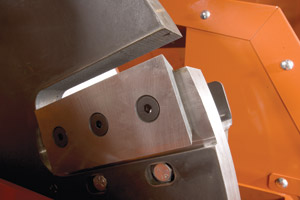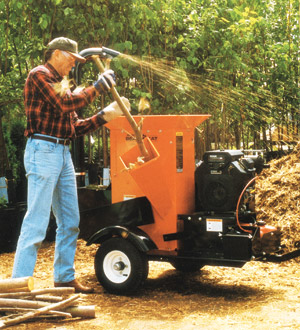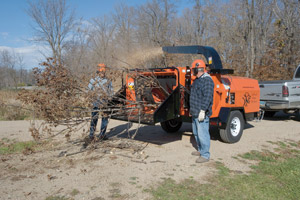
Knowing your market will improve profits
By Steve James
Features Business IntelligenceIn every market the disposal of organic material is at an all-time high. From fire bans in western Canada to the Emerald Ash Borer, where the only approved control method is chipping the wood into quarter-sized pieces, to landfill concerns in Ontario, to the increase of unusable limbs in firewood cutting across Quebec and the Maritimes, the opportunity for rental companies to increase their bottom line is there.
In every market the disposal of organic material is at an all-time high. From fire bans in western Canada to the Emerald Ash Borer, where the only approved control method is chipping the wood into quarter-sized pieces, to landfill concerns in Ontario, to the increase of unusable limbs in firewood cutting across Quebec and the Maritimes, the opportunity for rental companies to increase their bottom line is there. Understanding your market and investing in the correct piece of equipment will provide you with many years of profitability.
While many rental operators feel that it might be difficult to experience a return on their investment by renting out chippers, a quick explanation of the differences will help make a solid long-term money-making investment. Knowing what is on the market is the first step in becoming the “go-to person” in your service area for a year-round profit generator.
 Chipper blades should be checked and sharpened if needed after every rental and the anvil, also known as the strike plate, needs to be kept to the manufacturer’s specifications for the blades to work efficiently. |
A “chipper” is a machine that is generally engine driven, either by gas, diesel or the Power Take-Off (PTO) of a compact tractor. Chippers come in all sizes from 1.5 inches up to 20 inches and are primarily used to turn wood into mulch. A “chipper/shredder” on the other hand is used for reducing green organic material into shreds to improve the speed of composting. Chippers/ shredders also help reduce the volume of material to save time and energy when the end product needs to be hauled to a landfill. Many machines can perform both jobs simultaneously, so knowing what is best for your rental operation will help you decide which units to offer.
With both styles of machine, maintenance is the key to a solid return on your investment. Chipper blades should be checked and sharpened if needed after every rental. As well, the anvil, also known as the strike plate, needs to be kept to the manufacturer’s specifications, which ensure that the blades work efficiently. Premium brands of chippers/shredders use flail knives rather than stock metal bars. These knives are self-sharpening, but as they wear down they can be reversed to extend their life. Many machines also have options on discharge screens, which need to be cleaned from time to time. Stringy material can wrap around the shafts and decrease the performance of a machine. All bearings should be checked and greased on a regular basis.

Chipper/shredder machines are used for reducing green organic material into shreds to improve the speed of composting. They also help reduce the volume of shredded material destined for a landfill.
|
So, now, with so many choices, what should you rent? If you have tree service customers that need to remove the material from their worksite then you will need to have a machine that is capable of shooting the material into a trailer or the back of a pickup truck. Most machines have discharge chutes that will rotate 360 degrees, for example, Bear Cat has a unique machine with both a chipper bed and a chute that will rotate 360 degrees. This machine allows the operator to safely load from the curbside versus having their back toward oncoming traffic.
When investing in these larger machines, it is also recommended to use a machine that has a hydraulic feed feature. These machines will feed the material gradually and as the chipping disc slows down it will back off the feeding material until the disc reaches the optimum level of r.p.m. This type of “try again” feature will keep customers in check by not allowing them to abuse the equipment. These machines are also easier on the blades. Over the last few years, chippers have evolved and the latest style to hit the market offers cantilever discs. The discs on these machines are supported on the backside with double bearings, leaving the front side of the disc without a shaft. This prevents material from wrapping around the shaft, and results in less downtime. With material feeding closer to the centre of the disc, the machines can be physically smaller and more economical to run.
If you are primarily renting to homeowners, you will want the versatility of a chipper/shredder. This type of machine has a chute for inputting both tree limbs and branches, while the top hopper is perfect for leafy material and small branches up to three quarters of an inch in size. Rental duty units are available from three to five inches in size and can be towed or easily lifted into the back of a truck or van. The towable units have more horsepower and a chute as standard equipment, providing the ability to direct the end product where it is wanted. Smaller units fit the bill when they are used on properties up to half an acre.
 A “chipper” is a machine that is generally engine driven, either by gas, diesel or the PTO of a compact tractor. Chippers come in all sizes from 1.5 inches up to 20 inches and are primarily used to turn wood into mulch.
|
Chippers and chipper/shredder machines can also be marketed as environmentally friendly in many ways. A study done in Washington state determined that the average household generates 1,900 pounds of yard waste per year. If that amount of waste were burned, it would release 35 pounds of emission particulates known as PM2.5, while a small chipper/shredder would only produce a .05 pound of PM2.5. This is a reduction of 700:1.
If you are already renting these types of machines, one of your primary concerns should be the safety of your customers who operate them. Wear shirts with tighter fitting sleeves, gloves that fit well and comfortable safety glasses. Keep other people away from the machine while you are operating it. When putting a branch into a chipper, make sure that you feed the large end first. This will immediately tell you whether or not the piece of wood is going to fit. If the operator starts with the small end first it could feed up to the maximum diameter and then jam the machine. Above all, common sense plays an important part in operating a chipper.
Recommending the correct machine for your customer’s job will allow you to become the market professional when it comes to chippers/shredders, which will ultimately increase your profits as a rental operator.
*Steve James is a product specialist with Echo Power Equipment Canada based in London, Ont.
Print this page